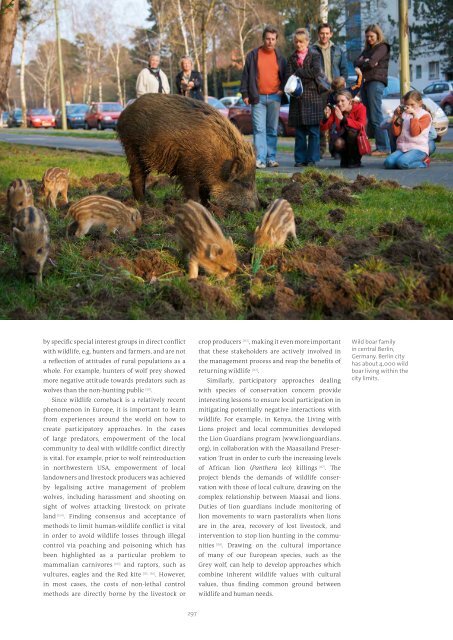130925-studie-wildlife-comeback-in-europe
Create successful ePaper yourself
Turn your PDF publications into a flip-book with our unique Google optimized e-Paper software.
y specific special <strong>in</strong>terest groups <strong>in</strong> direct conflict<br />
with <strong>wildlife</strong>, e.g. hunters and farmers, and are not<br />
a reflection of attitudes of rural populations as a<br />
whole. For example, hunters of wolf prey showed<br />
more negative attitude towards predators such as<br />
wolves than the non-hunt<strong>in</strong>g public [151] .<br />
S<strong>in</strong>ce <strong>wildlife</strong> <strong>comeback</strong> is a relatively recent<br />
phenomenon <strong>in</strong> Europe, it is important to learn<br />
from experiences around the world on how to<br />
create participatory approaches. In the cases<br />
of large predators, empowerment of the local<br />
community to deal with <strong>wildlife</strong> conflict directly<br />
is vital. For example, prior to wolf re<strong>in</strong>troduction<br />
<strong>in</strong> northwestern USA, empowerment of local<br />
landowners and livestock producers was achieved<br />
by legalis<strong>in</strong>g active management of problem<br />
wolves, <strong>in</strong>clud<strong>in</strong>g harassment and shoot<strong>in</strong>g on<br />
sight of wolves attack<strong>in</strong>g livestock on private<br />
land [154] . F<strong>in</strong>d<strong>in</strong>g consensus and acceptance of<br />
methods to limit human-<strong>wildlife</strong> conflict is vital<br />
<strong>in</strong> order to avoid <strong>wildlife</strong> losses through illegal<br />
control via poach<strong>in</strong>g and poison<strong>in</strong>g which has<br />
been highlighted as a particular problem to<br />
mammalian carnivores [103] and raptors, such as<br />
vultures, eagles and the Red kite [155, 156] . However,<br />
<strong>in</strong> most cases, the costs of non-lethal control<br />
methods are directly borne by the livestock or<br />
crop producers [137] , mak<strong>in</strong>g it even more important<br />
that these stakeholders are actively <strong>in</strong>volved <strong>in</strong><br />
the management process and reap the benefits of<br />
return<strong>in</strong>g <strong>wildlife</strong> [137] .<br />
Similarly, participatory approaches deal<strong>in</strong>g<br />
with species of conservation concern provide<br />
<strong>in</strong>terest<strong>in</strong>g lessons to ensure local participation <strong>in</strong><br />
mitigat<strong>in</strong>g potentially negative <strong>in</strong>teractions with<br />
<strong>wildlife</strong>. For example, <strong>in</strong> Kenya, the Liv<strong>in</strong>g with<br />
Lions project and local communities developed<br />
the Lion Guardians program (www.lionguardians.<br />
org), <strong>in</strong> collaboration with the Maasailand Preservation<br />
Trust <strong>in</strong> order to curb the <strong>in</strong>creas<strong>in</strong>g levels<br />
of African lion (Panthera leo) kill<strong>in</strong>gs [157] . The<br />
project blends the demands of <strong>wildlife</strong> conservation<br />
with those of local culture, draw<strong>in</strong>g on the<br />
complex relationship between Maasai and lions.<br />
Duties of lion guardians <strong>in</strong>clude monitor<strong>in</strong>g of<br />
lion movements to warn pastoralists when lions<br />
are <strong>in</strong> the area, recovery of lost livestock, and<br />
<strong>in</strong>tervention to stop lion hunt<strong>in</strong>g <strong>in</strong> the communities<br />
[158] . Draw<strong>in</strong>g on the cultural importance<br />
of many of our European species, such as the<br />
Grey wolf, can help to develop approaches which<br />
comb<strong>in</strong>e <strong>in</strong>herent <strong>wildlife</strong> values with cultural<br />
values, thus f<strong>in</strong>d<strong>in</strong>g common ground between<br />
<strong>wildlife</strong> and human needs.<br />
Wild boar family<br />
<strong>in</strong> central Berl<strong>in</strong>,<br />
Germany. Berl<strong>in</strong> city<br />
has about 4,000 wild<br />
boar liv<strong>in</strong>g with<strong>in</strong> the<br />
city limits.<br />
297


